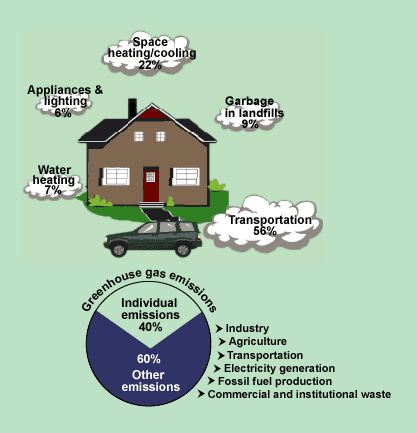
Natural Resources Canada > Earth Sciences Sector > Priorities > Climate Change Impacts and Adaptation > Climate Change in Canada
Weathering the changes: Climate change in Ontario How do we measure up?
Our challenge...
Our climate dictates that we use a significant amount of energy to heat and cool our houses, offices, and schools. We have a high standard of living, compared to many parts of the world, which means we have larger houses to heat and cool, larger and more cars, televisions, and computers, and we also travel more. All the things we buy and the trips we take consume energy. For these reasons, Canada is one of the largest per capita emitters of greenhouse gases in the industrialized world.

Did you know?
In washing machines, 92% of the energy is used by the hot water heater to heat water, and only 8% of the energy is actually used to run the machine. Using cold water to wash and rinse our clothes save up to 225 kg of CO2 a year.
Each of us is responsible for the choices we make.

1995 CO2 per capita emission of selected countries
(Environment Canada) |
Did you know?
- Every litre of gasoline you use in your car produces almost 2.5 kilograms of CO2, as well as other pollutants.
- Fifteen seconds of idling a car engine uses more fuel than restarting it.
- 'Jackrabbit' starts consume about 50 % more fuel than if you accelerate gradually.
- Purchasing locally produced food and other products reduces transportation emissions.
Did you know?
Improving energy efficiency is the fastest, cheapest, and surest way to reduce greenhouse gas emissions.
Did you know?
Replacing one frequently used regular light bulb with an energy efficient compact fluorescent bulb will save 225 kg of CO2 per year.
References
Energy Information Administration, 1998: Annual Energy Review 1997, Department of Energy, Washington D.C. (Revised by Torrie Smith Associates, 1999).
| 
